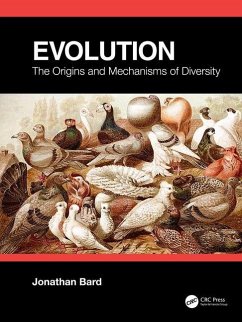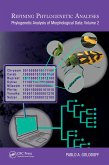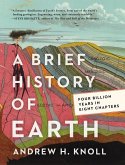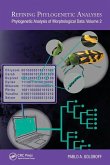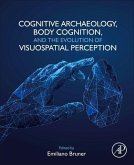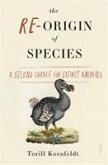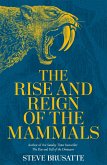Jonathan Bard (Balliol College, University of Oxford, Oxfordshire,
Evolution
The Origins and Mechanisms of Diversity
Jonathan Bard (Balliol College, University of Oxford, Oxfordshire,
Evolution
The Origins and Mechanisms of Diversity
- Broschiertes Buch
- Merkliste
- Auf die Merkliste
- Bewerten Bewerten
- Teilen
- Produkt teilen
- Produkterinnerung
- Produkterinnerung
Using this textbook, students will learn about cladistics, molecular phylogenies and the molecular-genetical basis of evolutionary change, including the important role of protein networks, symbionts and holobionts, together with the core principles of developmental biology.
Andere Kunden interessierten sich auch für
![Refining Phylogenetic Analyses Refining Phylogenetic Analyses]() Pablo A. GoloboffRefining Phylogenetic Analyses111,99 €
Pablo A. GoloboffRefining Phylogenetic Analyses111,99 €![Fossil Men Fossil Men]() Kermit PattisonFossil Men20,99 €
Kermit PattisonFossil Men20,99 €![A Brief History of Earth A Brief History of Earth]() Andrew H. KnollA Brief History of Earth20,99 €
Andrew H. KnollA Brief History of Earth20,99 €![Refining Phylogenetic Analyses Refining Phylogenetic Analyses]() Pablo A. GoloboffRefining Phylogenetic Analyses49,99 €
Pablo A. GoloboffRefining Phylogenetic Analyses49,99 €![Cognitive Archaeology, Body Cognition, and the Evolution of Visuospatial Perception Cognitive Archaeology, Body Cognition, and the Evolution of Visuospatial Perception]() Cognitive Archaeology, Body Cognition, and the Evolution of Visuospatial Perception143,99 €
Cognitive Archaeology, Body Cognition, and the Evolution of Visuospatial Perception143,99 €![The Re-Origin of Species The Re-Origin of Species]() Torill KornfeldtThe Re-Origin of Species22,99 €
Torill KornfeldtThe Re-Origin of Species22,99 €![The Rise and Reign of the Mammals The Rise and Reign of the Mammals]() Steve BrusatteThe Rise and Reign of the Mammals28,99 €
Steve BrusatteThe Rise and Reign of the Mammals28,99 €-
-
-
Using this textbook, students will learn about cladistics, molecular phylogenies and the molecular-genetical basis of evolutionary change, including the important role of protein networks, symbionts and holobionts, together with the core principles of developmental biology.
Hinweis: Dieser Artikel kann nur an eine deutsche Lieferadresse ausgeliefert werden.
Hinweis: Dieser Artikel kann nur an eine deutsche Lieferadresse ausgeliefert werden.
Produktdetails
- Produktdetails
- Verlag: Taylor & Francis Ltd
- Seitenzahl: 536
- Erscheinungstermin: 31. Dezember 2021
- Englisch
- Abmessung: 279mm x 211mm x 23mm
- Gewicht: 1588g
- ISBN-13: 9780367357016
- ISBN-10: 0367357011
- Artikelnr.: 62714780
- Herstellerkennzeichnung
- Libri GmbH
- Europaallee 1
- 36244 Bad Hersfeld
- gpsr@libri.de
- Verlag: Taylor & Francis Ltd
- Seitenzahl: 536
- Erscheinungstermin: 31. Dezember 2021
- Englisch
- Abmessung: 279mm x 211mm x 23mm
- Gewicht: 1588g
- ISBN-13: 9780367357016
- ISBN-10: 0367357011
- Artikelnr.: 62714780
- Herstellerkennzeichnung
- Libri GmbH
- Europaallee 1
- 36244 Bad Hersfeld
- gpsr@libri.de
Professor Jonathan Bard is a vertebrate developmental anatomist who has also published research papers in evolutionary, theoretical and systems biology and in bioinformatics. He worked at the MRC Human Genetics Unit and at the University of Edinburgh and is currently a graduate advisor at Balliol College Oxford.
Preface. SECTION I: AN INTRODUCTION TO EVOLUTION 1. Approaching Evolution
2. A Potted History of Evolutionary Science 3. The Ancient World 4. Life
Today: Species Diversity and Classification SECTION II. THE EVIDENCE FOR
EVOLUTION 5. Analysing Evolutionary Change 6. The Anatomical Evidence for
Evolutionary Change 7. The Genomic Evidence 8. The Evo-Devo Evidence
SECTION III: THE HISTORY OF LIFE 9. The First Two Billion Years 10. The
Roots of the Eukaryotic Tree of Life 11. The Evolution of Algae and Plants
12. The Evolution of Multicellular Organisms in the Ediacaran period 13.
The Cambrian Explosion and the Evolution of Protostomes 14. Deuterostome
Evolution: From the Beginnings to the Amphibians 15. Vertebrate Evolution:
Stem Mammals, Reptiles and Birds 16. Vertebrate Evolution: Mammals SECTION
IV: MECHANISMS OF EVOLUTION 17. Variation 1: Mutations and Phenotypes 18.
Variation 2: Evolutionary Change 19. Adaptation, Symbionts and Holobionts
20. Selection 21. Evolutionary Population Genetics 22. Speciation SECTION
V: HUMAN EVOLUTION 23. Human Evolution 1: The Fossil Evidence 24. Human
Evolution 2: Genes and Migrations 25. Human Evolution 3: The Origins of
Modern Humans 26. Conclusions Appendix 1. Systems Biology Appendix 2. A
History of Evolutionary Thought Appendix 3. A Brief History of the World
Appendix 4. Rocks, Dates and Fossils Appendix 5: Constructing Molecular
Phylogenies Appendix 6: Three Key Model Organisms: Mouse, Drosophila and
H. sapiens Appendix 7: Some Principles of Animal Developmental Biology
Appendix 8: Evolution Versus Creationism Glossary. Acknowledgements. Index.
2. A Potted History of Evolutionary Science 3. The Ancient World 4. Life
Today: Species Diversity and Classification SECTION II. THE EVIDENCE FOR
EVOLUTION 5. Analysing Evolutionary Change 6. The Anatomical Evidence for
Evolutionary Change 7. The Genomic Evidence 8. The Evo-Devo Evidence
SECTION III: THE HISTORY OF LIFE 9. The First Two Billion Years 10. The
Roots of the Eukaryotic Tree of Life 11. The Evolution of Algae and Plants
12. The Evolution of Multicellular Organisms in the Ediacaran period 13.
The Cambrian Explosion and the Evolution of Protostomes 14. Deuterostome
Evolution: From the Beginnings to the Amphibians 15. Vertebrate Evolution:
Stem Mammals, Reptiles and Birds 16. Vertebrate Evolution: Mammals SECTION
IV: MECHANISMS OF EVOLUTION 17. Variation 1: Mutations and Phenotypes 18.
Variation 2: Evolutionary Change 19. Adaptation, Symbionts and Holobionts
20. Selection 21. Evolutionary Population Genetics 22. Speciation SECTION
V: HUMAN EVOLUTION 23. Human Evolution 1: The Fossil Evidence 24. Human
Evolution 2: Genes and Migrations 25. Human Evolution 3: The Origins of
Modern Humans 26. Conclusions Appendix 1. Systems Biology Appendix 2. A
History of Evolutionary Thought Appendix 3. A Brief History of the World
Appendix 4. Rocks, Dates and Fossils Appendix 5: Constructing Molecular
Phylogenies Appendix 6: Three Key Model Organisms: Mouse, Drosophila and
H. sapiens Appendix 7: Some Principles of Animal Developmental Biology
Appendix 8: Evolution Versus Creationism Glossary. Acknowledgements. Index.
Preface. SECTION I: AN INTRODUCTION TO EVOLUTION 1. Approaching Evolution
2. A Potted History of Evolutionary Science 3. The Ancient World 4. Life
Today: Species Diversity and Classification SECTION II. THE EVIDENCE FOR
EVOLUTION 5. Analysing Evolutionary Change 6. The Anatomical Evidence for
Evolutionary Change 7. The Genomic Evidence 8. The Evo-Devo Evidence
SECTION III: THE HISTORY OF LIFE 9. The First Two Billion Years 10. The
Roots of the Eukaryotic Tree of Life 11. The Evolution of Algae and Plants
12. The Evolution of Multicellular Organisms in the Ediacaran period 13.
The Cambrian Explosion and the Evolution of Protostomes 14. Deuterostome
Evolution: From the Beginnings to the Amphibians 15. Vertebrate Evolution:
Stem Mammals, Reptiles and Birds 16. Vertebrate Evolution: Mammals SECTION
IV: MECHANISMS OF EVOLUTION 17. Variation 1: Mutations and Phenotypes 18.
Variation 2: Evolutionary Change 19. Adaptation, Symbionts and Holobionts
20. Selection 21. Evolutionary Population Genetics 22. Speciation SECTION
V: HUMAN EVOLUTION 23. Human Evolution 1: The Fossil Evidence 24. Human
Evolution 2: Genes and Migrations 25. Human Evolution 3: The Origins of
Modern Humans 26. Conclusions Appendix 1. Systems Biology Appendix 2. A
History of Evolutionary Thought Appendix 3. A Brief History of the World
Appendix 4. Rocks, Dates and Fossils Appendix 5: Constructing Molecular
Phylogenies Appendix 6: Three Key Model Organisms: Mouse, Drosophila and
H. sapiens Appendix 7: Some Principles of Animal Developmental Biology
Appendix 8: Evolution Versus Creationism Glossary. Acknowledgements. Index.
2. A Potted History of Evolutionary Science 3. The Ancient World 4. Life
Today: Species Diversity and Classification SECTION II. THE EVIDENCE FOR
EVOLUTION 5. Analysing Evolutionary Change 6. The Anatomical Evidence for
Evolutionary Change 7. The Genomic Evidence 8. The Evo-Devo Evidence
SECTION III: THE HISTORY OF LIFE 9. The First Two Billion Years 10. The
Roots of the Eukaryotic Tree of Life 11. The Evolution of Algae and Plants
12. The Evolution of Multicellular Organisms in the Ediacaran period 13.
The Cambrian Explosion and the Evolution of Protostomes 14. Deuterostome
Evolution: From the Beginnings to the Amphibians 15. Vertebrate Evolution:
Stem Mammals, Reptiles and Birds 16. Vertebrate Evolution: Mammals SECTION
IV: MECHANISMS OF EVOLUTION 17. Variation 1: Mutations and Phenotypes 18.
Variation 2: Evolutionary Change 19. Adaptation, Symbionts and Holobionts
20. Selection 21. Evolutionary Population Genetics 22. Speciation SECTION
V: HUMAN EVOLUTION 23. Human Evolution 1: The Fossil Evidence 24. Human
Evolution 2: Genes and Migrations 25. Human Evolution 3: The Origins of
Modern Humans 26. Conclusions Appendix 1. Systems Biology Appendix 2. A
History of Evolutionary Thought Appendix 3. A Brief History of the World
Appendix 4. Rocks, Dates and Fossils Appendix 5: Constructing Molecular
Phylogenies Appendix 6: Three Key Model Organisms: Mouse, Drosophila and
H. sapiens Appendix 7: Some Principles of Animal Developmental Biology
Appendix 8: Evolution Versus Creationism Glossary. Acknowledgements. Index.

